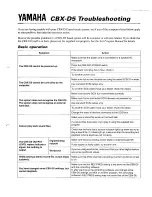
Installation
6
NOTICE:
Allow for overlap when cutting piping and run a trial
(dry) fitting before you glue.
1.
Use PTFE pipe thread sealant tape on male ends of
discharge pipe. Thread the 1-
1/4” x 1
-
1/2” elbow (supplied)
onto the discharge. When tight, the elbow must point up.
2.
If possible, install the Battery Backup Unit (BBU) on the
floor of the sump; be sure that the two pumps do not touch
each other and do not interfere with switch operation.
NOTICE:
If debris or gravel is present in the bottom of the
sump pit that could get sucked up into the pump, set both
the primary sump pump and the BBU up on bricks or cinder
blocks to prevent clogging.
3.
If the sump is too small to allow both pumps to sit on the
bottom of the sump, install an angle bracket on the primary
sump pump’s disch
arge pipe with stainless steel hose
clamps. Mount the backup pump on the angle bracket. See
Figure 1, “Separate Discharge”.
4.
Cut a piece of 1-
1/2” PVC pipe to reach from the backup
pump discharge elbow to about one (1) foot above the
basement floor. This is the lower discharge pipe.
5.
To prevent airlocking the pump during operation, drill a
1/8” hole in the lower discharge pipe about 2” above the
bottom of the pipe (below floor level).
6.
Install FP0026-10 check valve (purchase separately) on the
upper end of the pipe. Tighten the hose clamps securely.
BE SURE that the flow arrows point UP (away from the
BBU). If they point down, the valve will not pass water and
the pump will not work.
7.
Cut a short length of 1-
1/2” PVC pipe for a riser pipe and
clamp it into the top of the check valve.
8.
Install a U74-68 Hose and Clamp Assembly on the top of
the riser pipe. For 1-
1/2” pipe, remove and discard the
short piece of 1-
1/4” hose in the Hose and Clamp
Assembly. Leave the hose clamps loose and slide the
Assembly down below the top of the riser pipe.
9.
Determine where you want the discharge to exit the
basement. At that point, drill the necessary holes (large
enough to have clearance for a 1-
1/2” pipe) to allow you to
run the discharge pipe from above the sump to the
outdoors.
10.
Install the horizontal discharge pipe. Install a 90° elbow on
the inside end but do not glue.
11.
Cut another short piece of 1-
1/2” PVC for the Upper
Discharge Pipe to run from the top of the riser pipe up to
the 90° elbow. Be sure to allow enough overlap for the glue
joint in the elbow.
12.
Do a trial fit with NO GLUE, installing the 1-
1/2” upper
discharge pipe in the 90° elbow and the upper discharge
pipe in the vertical end of the 90° elbow. The upper
discharge pipe should just fit between the riser pipe and
the elbow.
13.
Risk of fire and chemical inhalation.
Whenever using PVC primer and PVC cement, follow the
glue manufacturer’s instructions.
14.
Make sure that the BBU will clear the primary sump pump
and its switch. If there isn’t room for both pumps to sit on
the floor of the sump, the BBU will have to be raised
(depending on your particular situation).
15.
Clean, prime and glue the upper discharge pipe into the
90º elbow. When the glue has set, slide the Hose and
Clamp Assembly up to cover the joint and tighten all the
hose clamps.
16.
Install the Battery Backup Switch as shown, 1” above start
water level of primary pump. Fasten it to the pipe with
cable ties.
17.
Tape the pump cord to the riser pipe so that the plug
cannot fall into the sump.
18.
Go to “BBU WIRING AND SETUP” (Page 8) for wirin
g
instructions.
19.
Once all wiring is complete, fill your pit with water and
verify that the PSP removes the water and the BBU doesn’t
run. Then, unplug your PSP and refill your pit with water.
Verify that the BBU pump removes the water.
20.
Make sure that the power is on to both pumps, and your
system is ready to use.



































